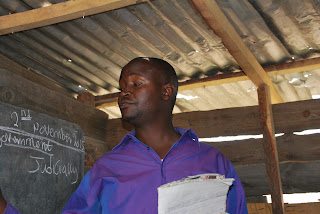 |
| A little blurry from the moving car -- one of many "lakes" on our drive |
February is the middle of the rainy season here. This year however the rain has not been
as plentiful as usual. The water
table remains low and rolling blackouts and water rationing continue. The heat yesterday reminded us of the heat in October or November. This morning
my window was open and I could feel a breeze and later the wind. Suddenly it grew a bit dark. The thunder started rolling, lightening
flashed, and the rain poured down.
It was a welcomed sight but the lake-like puddles in the road delayed
traffic and made our drive to Chawama a challenge.
 |
| Jeno checking for understanding |
Mabuchi and I observed four teachers today at Chawama. We began with Jeno, the grade seven
teacher who sometimes wears a lab coat. He
had training from me in November. He
taught a lesson on multiplying fractions. The students seemed to grasp the concepts and interact well.
During the post-observation conference I reminded him how to represent
fractions with pictures as well as using the algorithm to solve the
problem. He had many questions and
is eager to learn.
 |
| Grade 7 students discuss how they solved the problem |
 |
| Teacher Mercy write the lesson on the board - Mabuchi looks on |
One of the new teachers, Mercy, teaches grade one. She drew
pictures on the board for the students to count and asked them to write the
numbers represented. During the post-observation conference she said that next
time she would use concrete objects instead to teach the concepts. We discussed what type of concrete
objects she might use for counters including the students’ fingers.
Precious, the grade two teacher, who has had one training, taught
a lesson about things we use to stay clean, such as toothpaste, soap, a towel
etc.
 |
| Teacher Precious takes her teaching seriously |
The students did well on the
assignment and during the post-observation conference the teacher mentioned
several ways she could make the lesson more relevant to the students.
 |
| Mr. Lundu's kind and soft spoken manner add to his love for children |
The grade three lesson was on division. The teacher, Mr. Lundu, who has
received no training, introduced the concept by saying division comes from the
word “divide” and divide means to share. I thought phrasing it in such a way described it well and made sense to the students. Mr. Lundu used a lot of “turn and talk” during the
lesson and “write the number on your paper and share with your friends.” The number he used for the students to
divide was quite large which made it difficult for his pupils to solve but he
was on the right track with his engagement strategies.
Finally, we ended our observations with Miss Mtonga, the new
grade four teacher. She began with
a review from yesterday about synonyms and introduced today’s lesson about
antonyms. She had some good
strategies in place and we were able to talk about how to make her practice
stronger by utilizing a few others.
 |
| Miss Mtonga writes the exercise on the board |
During the post-observation conference time with teachers I always
go back and ask about the learning objective; what specifically the teacher
wants the students to learn that day. That usually takes some discussion before
we get to the specific objective and understanding of what they should teach. Writing a clear and concise objective
is a challenge for most teachers.
We will continue to practice this.
 |
| Grade three students share their answers with their partners |
The skies cleared up at the end of the day and the sun came
back out. In fact it is quite warm
again this evening. There might be
rain again tomorrow.



















































